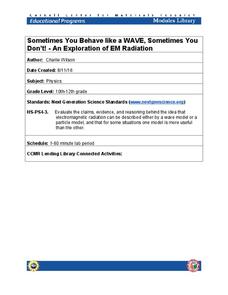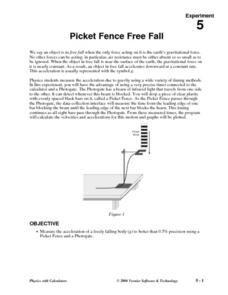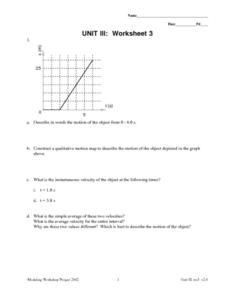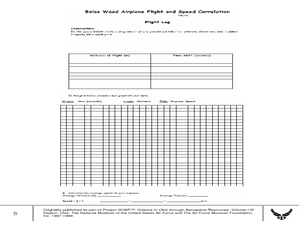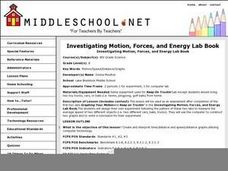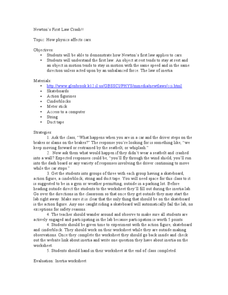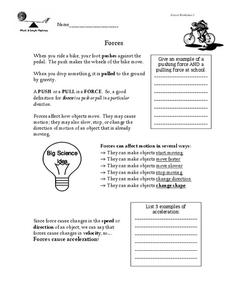It's About Time
Automatic Triggering Devices
How does the air bag trigger in an accident? The lesson explores how automatic triggering devices work in automobiles. Using examples such as a seat belt lock and air bag, scholars design their own device to better understand the...
Cornell University
Sometimes You Behave Like a WAVE, Sometimes You Don't!
Electromagnetic radiation behaves like both a wave and a particle. Help classes explore this concept through a lab investigation. Young scientists create optical interference patterns on a glass slide using a carbon layer. They analyze...
Magic of Physics
Moving Toy Mechanisms
Who says playing around in class is a bad idea? Precocious physicists engage in building mechanisms that include cams, gears, pulleys, and levers using an interactive lesson. After completing toy tutorials about each topic, users build a...
Magic of Physics
Springs Lab
Stretch young minds in their understanding of springs! Add an interesting interactive to promote awareness of factors such as stiffness, ground friction, and air resistance. The resource contains custom controls, allowing individuals to...
Curated OER
Levers and Pulleys
Seventeen pages of material leave you well-prepared to carry out this lesson on levers and pulleys. Photos and diagrams make the instructions clear; resource links provide additional information. The missing aspects of this teacher's...
Curated OER
Bronx Cheer Bulb
If you chew or make a "raspberry" while viewing an LED light source, the light will appear to wiggle or flicker. It is not because of the light itself, but because of the vibration of your skull! Have your physics class give this a try...
Curated OER
Mystery of the Megaplume
Read through the extensive background information and then lead your geology or physical oceanography class through an investigation of actual temperature anomaly data from the Juan de Fuca ridge. They translate the data onto a plot,...
Curated OER
No Flaw With Newton’s 1st Law
Students explain what inertia is in their own words. In this physics lesson, students investigate how Newton's first law applies to their robot. They discuss real world examples of the 1st law.
Curated OER
The Raw of Newton’s 3rd Law
Students identify the action and reaction forces acting on the CEENBoT. For this physics lesson, students describe everyday applications of Newton's 3rd Law. They create a cluster word web about this law.
Curated OER
Picket Fence Free Fall
Young scholars measure acceleration using a Picket Fence and a Photogate. In this physics lesson, students drop an object and measure the acceleration of the object free falling. They log their data using the TI.
Curated OER
Marble Madness
Middle schoolers determine the velocity of a marble rolling down the incline. In this physics lesson plan, students identify the independent and dependent variables in the experiment. They construct and analyze a graph.
Curated OER
Secondary Robot
Students identify the forces acting on a stationary/constant velocity robot. In this physics lesson, students draw a free body diagrams of the forces. They explain the difference between zero acceleration and zero net force.
Curated OER
Unit III: 3
In this unit III: 3 worksheet, students describe motion in words and graph drawings. Students calculate the instantaneous velocity and average velocity. Students also graph the displacement of the object in the word problems.
Curated OER
Balsa Wood Airplane Flight and Speed Correlation
Ninth graders calculate the average speed of their balsa wood airplane. For this physics lesson, 9th graders build their own airplane and make necessary modifications to to make it fly straight. They interpret distance and time graph...
Curated OER
Investigating Motion, Forces, and Energy Lab Book
Eighth graders create their own experiements using toy trucks, cars or balls to measure the time it takes two of them to travel 5 meters, as well as at each 1 meter interval. They make use computers to make a time/distance graph and...
Curated OER
Force Counterforce
Students hypothesize what forces affect the motion of a falling body. For this physical science lesson, students create diagrams and illustrations to support their hypothesis. They perform the experiment and record observations.
Curated OER
Newton's First Law Crash!!
Students examine Newton's first law of motion and demonstrate how it applies to cars. In this motion lesson students complete an experiment and worksheet on speed and inertia.
Curated OER
Balloon Rockets
Students, after reviewing and analyzing Newton's third law of motion, make balloon rockets and experiment with a variety of models. After the experiment, they chart the results and form conclusions. In addition, they compare/contrast...
Curated OER
Forces
In this forces worksheet, students read about force and acceleration. They complete a Venn Diagram to compare and contrast balanced and unbalanced forces, they answer questions about a diagram of a tug-a-war and the forces acting on each...
Curated OER
Moving Bodies
In this moving bodies worksheet, students investigate how the amount of mass of a body in motion affects its tendency to remain in motion. Students use a meter stick as a ramp, marbles, string and a wooden block to determine how far a...
Curated OER
Simple Machines
Fourth graders discover the principles and uses of gears noting that they can be used to change the direction of motion or the speed of an object. They may also change the force and/or distance through which an object turns. They then...
Curated OER
Simple Machines V - Wheels and Axles and Gears
Fourth graders investigate the principles and uses of gears, and examine how gears can be used to alter the direction of motion or the speed of an object. They observe two cars with different sized wheels roll down an inclined plane,...
Curated OER
F = a, Inertia, and Friction
Fourth graders use a matchbox car to push across a hard surface and observe what happens. They then push the car across a soft or rough surface and discover what happens. The two ideas are discusses as Newton's First and Second Laws of...
Curated OER
May The Force Be With You
Eighth graders investigate Newton's Laws of Motion. They use the example of a roller coaster for illustration purposes. A force associated with a roller coaster is tested, data graphed, and a conclusion is drawn. They use excel in order...



